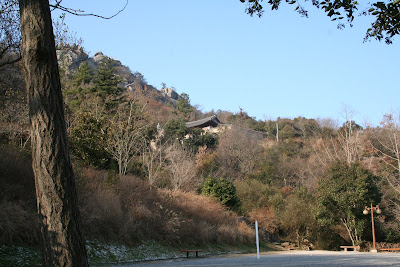Let's talk about the most infamous bit of traditional Korean cuisine.
I've eaten dog once in my life (that I know of), when I was invited out to a boshintang restaurant. Overall I didn't find the taste of dog meat to be all that remarkable at all (it tasted something like lamb); I found the pepper mixture served in a side dish to have a far more interesting flavor to it.
I don't know many people personally who have taken a strong moral stand against eating dog. Of course, if you regularly eat cow, pig, and lamb, it's really difficult to say that dogs (or horses or cats or kangaroos) should be considered off-limits for food without sounding like a chauvinistic cultural bully. (Maybe if you are a committed vegetarian you'd be able to make a more persuasive moral case.)
But that said, it gets a bit more complicated when you bring up the allegations that people who slaughter dogs for food are in the habit of beating and torturing them first, because that will make the meat taste better (or something). I have heard from sources I consider reliable that this is only an urban legend. And I have heard from
other sources I consider reliable that it is
really true. So I'm not sure what to believe.
A lot of Koreans I know say they hate the idea of eating dog and never want to try it themselves. That said, no Korean person I've ever met has ever expressed disapproval of
other people eating dog meat.
And I can't say I disapprove of it either, even though I'm not likely to try it again. Not long after trying dog soup for the first (and so far only) time, I was exploring a neighborhood near Dongdaemun when I happened upon a dog store. Not a pet store - a dog store, selling live dogs. Who were sitting in cages outside, panting in the heat. No question about what their eventual fate would be.
I know it's an illogical, irrational reaction (did the pigs and cows who produced the beef and pork I eat have lives that were any more pleasant?) but I haven't even considered eating dog meat since then.
 Cheonggyecheon in the holiday season.
Cheonggyecheon in the holiday season. Sorry about the blur. I blame the long exposure time needed in this light.
Sorry about the blur. I blame the long exposure time needed in this light.


 This is in a park on Yudalsan in Mokpo. That walkway is meant to be walked on barefoot. The stones stimulate the pressure points on your feet in a way that's beneficial. Unless you've never had your feet stimulated quite in that way, in which case it's just uncomfortable.
This is in a park on Yudalsan in Mokpo. That walkway is meant to be walked on barefoot. The stones stimulate the pressure points on your feet in a way that's beneficial. Unless you've never had your feet stimulated quite in that way, in which case it's just uncomfortable. Squid out to dry.
Squid out to dry. The Old Man and the Sea Restaurant. I believe it's the same one that Lonely Planet mentions as the Hemingway Restaurant. Interesting evolution. (The sea is directly to the left here.)
The Old Man and the Sea Restaurant. I believe it's the same one that Lonely Planet mentions as the Hemingway Restaurant. Interesting evolution. (The sea is directly to the left here.) Mermaid sculpture.
Mermaid sculpture. There are places where you can rent motorboats and waterskis - presumably more popular in the summer months.
There are places where you can rent motorboats and waterskis - presumably more popular in the summer months.
 Mokpo's a harbor city in Jeollanam-do.
Mokpo's a harbor city in Jeollanam-do. Reading this, it seems I missed the part of the city most foreigners congregate. I never made it to Hadang. But wandering around the old downtown area was enough for one day.
Reading this, it seems I missed the part of the city most foreigners congregate. I never made it to Hadang. But wandering around the old downtown area was enough for one day. Yudalsan dominates the old city area. It's a great place to climb for views of the city.
Yudalsan dominates the old city area. It's a great place to climb for views of the city.


